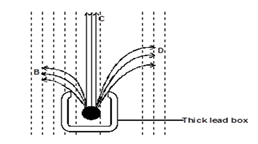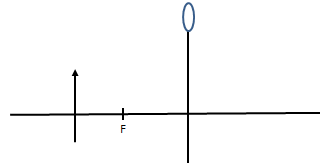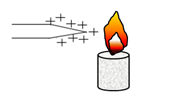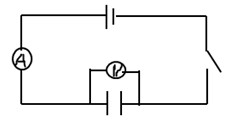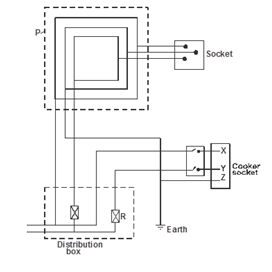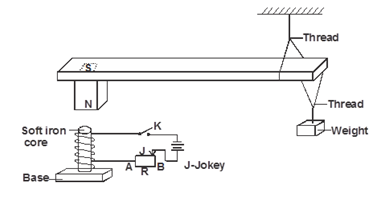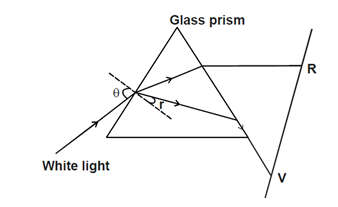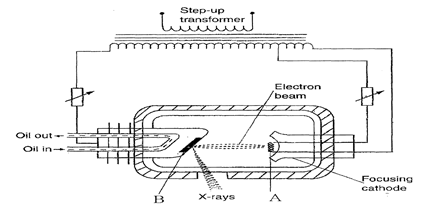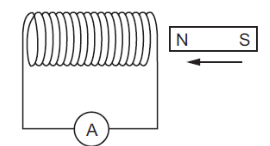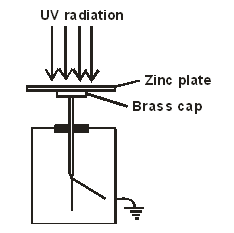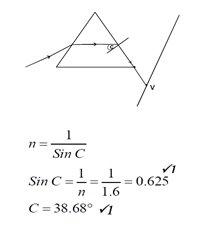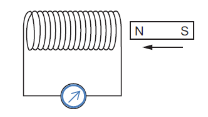Instructions to candidates
- Answer all questions in this question paper.
- Answers to all questions must be written in the spaces provided in this booklet.
- This paper consists of Two Sections A and B in the spaces provided.
- All working MUST be clearly shown.
- Electronic calculators and mathematical tables may be used.
- KNEC mathematical tables and non-programmable silent electronic calculators may be used.
Note: - Take acceleration due to gravity, g = 10m/s2, C = 3.0×108ms-1, Me = 9.11×10-31kg, e = 1.6×10-19C
- This paper consists of fourteen printed pages. Candidates should check to ascertain that all pages are printed as indicated and that no questions are missing.
- Figure 1 shows two plane mirrors AB and BC inclined at an angle of 100o. A ray of light is incident on mirror AB at an angle 50 Complete the diagram to show the path of the ray on reflection from mirror BC. 3mks
- Explain what is observed when an uncharged aluminum sphere is brought close to a positively charged electroscope (2mks)
- The chart below shows an arrangement of different parts of the electromagnetic
Radio wave
A
B
Visible light
C
D
E
- Name the radiation represented by A. (1mk)
- Name one detector of radiation C (1mk)
- State one difference in mode of production of radiation D and E (1mk)
- Name the radiation represented by A. (1mk)
- A lady holds a large concave mirror of focal length 1m, 80cm from her face. State one characteristic of her image in the mirror. (1mk)
- A ship produces an ultrasonic pulse and an echo is received from the sea bed after 8s. Assuming the speed of sound in sea water is 1500m/s, calculate the depth of the sea (3mks)
- Figure 2 shows a radioactive substance contained in a thick lead box and emitting radiations B, C and D. Passing through a strong field directed out of the plane of the paper.
- Identify the radiation labelled D. (1 marks)
- Uranium -234 undergoes a radioactive decay by emitting 2-alpha particles,as represented by the equation shown below.
Find the value of a and b (2 marks)
- When a bulb is connected between two plates of a simple cell the bulb lights up. However, the brightness of the bulb fades after a while. why does the brightness fall?(1 mark)
- Draw the magnetic field lines due to the configuration shown below. (1 mark)
- How much current is taken by a bulb rated 100w, 250V. (2 marks)
- The diagram in the figure 5.0 below shows an object O placed infront of a converging lens.
Using ray diagram determine the position of the image. (3 marks)
- The figure below shows a displacement- time graph for a wave.
Determine the frequency of the waveform (3mks )
- Figure shows an experimental arrangement S1 , S2 and S are narrow slits.
State what is observed on the screen when the source is monochromatic light. (1 mark)
SECTION B (55 MARKS)
-
- In an experiment with a parallel plate capacitor by form three students, the charge which was stored was measured for different values of charging p.d. From the results obtained, the following graph was plotted.
- Use the graph to calculate the capacitance of the capacitor used in the experiment. (3mks)
- State two factors affecting the capacitance. (2mks)
- Use the graph to calculate the capacitance of the capacitor used in the experiment. (3mks)
- A positively charged rod is brought near a flame as shown, State and explain what is observed (2mks)
- The figure below shows part of a circuit containing two capacitors of 4µF and 6µF respectively. Determine the p.d. across AB given that the total charge in the capacitors is 1 x 10-6C (2mks)
- the figure below shows a charging circuit of a capacitor. State two ways in which one can tell the capacitor is fully charged (2mks)
- In an experiment with a parallel plate capacitor by form three students, the charge which was stored was measured for different values of charging p.d. From the results obtained, the following graph was plotted.
-
- The diagram below is a section of a house wiring system.
Name:- Circuit labelled P (1 mark)
- Terminals labelled X and Y (2marks)
- Explain why R is connected to Y and not X. (1 mark)
- Why is the earthing necessary in such a circuit? (1 mark)
- Circuit labelled P (1 mark)
- The cost of electricity per kilowatt hour- kWh is Ksh.8, determines how much a household running a device rated 1500W continuously for 1.08 x 105 seconds, would pay. (2 marks)
- Explain reason for transmission of electrical power over along distance at very high voltage. (1 mark)
- Explain why for transmission of electrical power over long distance, alternating current (a.c) is preferred to a direct current (d.c) (1 mark)
- Figure below shows suspended metre rule in equilibrium balanced by the magnet and weight shown. The iron core is fixed to the bench.
- State and explain the effect on the metre rule when the switch S is closed. (2 marks)
- Suggest how J on the set up can be varied to have the effect in (i) above faster. (1mk)
- State the effect on the metre rule when the terminals of battery are reversed.
- The diagram below is a section of a house wiring system.
-
- The figure 10.0 below shows a ray of white light dispersed in a triangular prism. The speed of violet light in the prism in 1.88 × 108m/s.
- Explain how glass disperses white light into red and violet bands. (1 mark)
- Determine the refractive index of the prism material for light (take speed of light in vacuum = 3×108m/s (2 marks)
- Show on the figure the critical angle C for violet light and determine its value. (3 marks)
- On the same figure, sketch the part of red light after white light strikes the prism if the prism was replaced by another of similar shape but lower refractive index. (Use a dotted line for the answer) (1 mark)
- Explain how glass disperses white light into red and violet bands. (1 mark)
- State one condition under which total internal reflection occurs (1mk)
- The diagram below shows a ray of light entering a thin optical tube.
Draw on the same diagram the route taken by the ray until it leaves the tube 1mk)
- The figure 10.0 below shows a ray of white light dispersed in a triangular prism. The speed of violet light in the prism in 1.88 × 108m/s.
-
- Name two properties common to both X-rays and gamma rays. (2 marks)
- The figure below shows an X-ray tube.
- Name the parts labelled A and B (2 marks)
- State the function of part A above (1 mark)
- State the property of part B above (1 mark)
- For a given source of X-rays, how would the following be controlled?
- Penetration power. (1 mark)
- Intensity. (1 mark)
- Penetration power. (1 mark)
- An X-ray tube operates with a potential difference of 150 kV between the cathode and the anode. Only 0.5% of the kinetic energy of each electron is converted into X-rays. (Take electronic charge, e = 1.6 x 10-19C). Determine the maximum kinetic energy of the X-rays produced (2 marks)
- Name two properties common to both X-rays and gamma rays. (2 marks)
- The diagram below shows a coil connected to a zero-centered galvanometer G.
-
- Show on the diagram direction in which the galvanometer deflects. (1 mark)
- Explain the deflection of the galvanometer when the magnet is moved slowly towards the coil. (2 mark)
- A 240V mains transformer has 1000 turns in the primary and Ns turns in the secondary if it is used to supply 12V, 24W lamp.
- How many turns, Ns are there in the secondary. (2 marks)
- What is the efficient of the transformer if the current drawn from the 240V supply is 12mA. (2 marks)
- State two ways in which power loss can be minimized in a transformer. (2 marks)
- The figure below shows a set up that was used to demonstrate the photoelectric effect.
- If the electroscope was negatively charged, State the observation made. (1 mark)
- Explain your answer in (i) above. (2 marks)
- If the electroscope was negatively charged, State the observation made. (1 mark)
-

MARKING SCHEME
- Figure 1 shows two plane mirrors AB and BC inclined at an angle of 100o. A ray of light is incident on mirror AB at an angle 50 Complete the diagram to show the path of the ray on reflection from mirror BC. 3mks
-First and second reflection
-Cut angles correct
- Explain what is observed when an uncharged aluminum sphere is brought close to a positively charged electroscope (2mks)
Leaf falls/collapses/divergence decreases
Charge is induced into the sphere causing repulsion of electron to the leaf and hence the leaf falls
- The chart below shows an arrangement of different parts of the electromagnetic
Radio wave
A
B
Visible light
C
D
E
- Name the radiation represented by A. (1mk)
Microwave - Name one detector of radiation C (1mk)
Photographic film, photocells, fluorescent material
Any one - State one difference in mode of production of radiation D and E (1mk)
X-rays occurs due to electron transition between the energy levels while gamma radiations occurs due to nuclear reaction of an unstable atom/ or
- Name the radiation represented by A. (1mk)
- A lady holds a large concave mirror of focal length 1m, 80cm from her face. State one characteristic of her image in the mirror. (1mk)
Magnified
Upright / erect
Virtual
any one
- A ship produces an ultrasonic pulse and an echo is received from the sea bed after 8s. Assuming the speed of sound in sea water is 1500m/s, calculate the depth of the sea (3mks)
V=1/2 dt = 0.5x1500x 0.8 =600 m/s
- Figure 2 shows a radioactive substance contained in a thick lead box and emitting radiations B, C and D. Passing through a strong field directed out of the plane of the paper.
- Identify the radiation labelled D. (1 marks)
alpha - Uranium -234 undergoes a radioactive decay by emitting 2-alpha particles,as represented by the equation shown below.
Find the value of a and b (2 marks)
a=234
b=88
- Identify the radiation labelled D. (1 marks)
- When a bulb is connected between two plates of a simple cell the bulb lights up. However, the brightness of the bulb fades after a while. why does the brightness fall?(1 mark)
- Brightness falls due to cell defect (Local action and polarization)
- Draw the magnetic field lines due to the configuration shown below. (1 mark)
- How much current is taken by a bulb rated 100w, 250V. (2 marks)
P=VI
I=P/V=100/250=0.4 A
- The diagram in the figure 5.0 below shows an object O placed infront of a converging lens.
Using ray diagram determine the position of the image. (3 marks)
- The figure below shows a displacement- time graph for a wave.
Determine the frequency of the waveform (3mks )
T=2.0 x 10-6s f
1/T= 1/2.0 x 10-6= 5.0 x 105HZ
- Figure shows an experimental arrangement S1 , S2 and S are narrow slits.
State what is observed on the screen when the source is monochromatic light. (1 mark)
Alternating bright and dark fringes/bands are formed on the screen
SECTION B (55 MARKS)
-
- In an experiment with a parallel plate capacitor by form three students, the charge which was stored was measured for different values of charging p.d. From the results obtained, the following graph was plotted.
- Use the graph to calculate the capacitance of the capacitor used in the experiment. (3mks)
Capacitance =slope=7.5×10(-6) - State two factors affecting the capacitance. (2mks)
-Area of overlap
-Distance of separation
-Material/media between the plates/ dielectric
- Use the graph to calculate the capacitance of the capacitor used in the experiment. (3mks)
- A positively charged rod is brought near a flame as shown, State and explain what is observed (2mks)
-the flame bends towards the point charge/the flame splits - The figure below shows part of a circuit containing two capacitors of 4µF and 6µF respectively. Determine the p.d. across AB given that the total charge in the capacitors is 1 x 10-6C (2mks)
Total capacitance=4+6=10µF
Q=CV
V=Q/C= 0.1V - the figure below shows a charging circuit of a capacitor. State two ways in which one can tell the capacitor is fully charged (2mks)
V reads 4.5V / Maximum/equal to cell emf
A reads zero
- In an experiment with a parallel plate capacitor by form three students, the charge which was stored was measured for different values of charging p.d. From the results obtained, the following graph was plotted.
-
- The diagram below is a section of a house wiring system.
Name:- Circuit labelled P (1 mark)
P - main ring circuit - Terminals labelled X and Y (2marks)
X - neutral terminal
Y - positive / live terminal - Explain why R is connected to Y and not X. (1 mark)
Ensure when R breaks the appliance does not remain live - Why is the earthing necessary in such a circuit? (1 mark)
To guard against electric shock channel / transfer excess charges to ground
- Circuit labelled P (1 mark)
- The cost of electricity per kilowatt hour- kWh is Ksh.8, determines how much a household running a device rated 1500W continuously for 1.08 x 105 seconds, would pay. (2 marks)
- Explain reason for transmission of electrical power over along distance at very high voltage. (1 mark)
High voltage leads to low current hence lower power losses - Explain why for transmission of electrical power over long distance, alternating current (a.c) is preferred to a direct current (d.c) (1 mark)
Alternating current (a.c) can easily be stepped up to high voltage - Figure below shows suspended metre rule in equilibrium balanced by the magnet and weight shown. The iron core is fixed to the bench.
- State and explain the effect on the metre rule when the switch S is closed. (2 marks)
The metre rule tilt anticlockwise when switch is closed current flows in coil magnetising bar. End of coil facing magnet become south pole hence attract magnet to which ruler is attached - Suggest how J on the set up can be varied to have the effect in (i) above faster. (1mk)
Move jockey J from B toward A / right to left of R. to allow most current to flow - State the effect on the metre rule when the terminals of battery are reversed.
Metre rule tilt clockwise or weight comes down while magnet moves upwards. Reversing terminals reverses direction of current hence polarity of electro magnet. End facing magnet become North Pole hence repulsion (1 mark)
- State and explain the effect on the metre rule when the switch S is closed. (2 marks)
- The diagram below is a section of a house wiring system.
-
- The figure 10.0 below shows a ray of white light dispersed in a triangular prism. The speed of violet light in the prism in 1.88 × 108m/s.
- Explain how glass disperses white light into red and violet bands. (1 mark)
Red and violet light travel at different velocities in glass leading to separation. - Determine the refractive index of the prism material for light (take speed of light in vacuum = 3×108m/s (2 marks)
- Show on the figure the critical angle C for violet light and determine its value. (3 marks)
- On the same figure, sketch the part of red light after white light strikes the prism if the prism was replaced by another of similar shape but lower refractive index. (Use a dotted line for the answer) (1 mark)
- Explain how glass disperses white light into red and violet bands. (1 mark)
- State one condition under which total internal reflection occurs (1mk)
the light should move from dense to less dense medium
the angle of incidence in the denser medium should be greater than the critical angle - The diagram below shows a ray of light entering a thin optical tube.
Draw on the same diagram the route taken by the ray until it leaves the tube 1mk)
- The figure 10.0 below shows a ray of white light dispersed in a triangular prism. The speed of violet light in the prism in 1.88 × 108m/s.
-
- Name two properties common to both X-rays and gamma rays. (2 marks)
- Travels in a straight line at velocity of light
- do not require medium for transmission
-are transverse in nature - The figure below shows an X-ray tube.
- Name the parts labelled A and B (2 marks)
A- Filament
B-Tungsten target - State the function of part A above (1 mark)
A-Produce electrons by thermionic emission - State the property of part B above (1 mark)
A metal of high melting point
- Name the parts labelled A and B (2 marks)
- For a given source of X-rays, how would the following be controlled?
- Penetration power. (1 mark)
Varying the accelerating potential difference between the cathode and the anode - Intensity. (1 mark)
Varying the heating current to vary the number of electrons produced
- Penetration power. (1 mark)
- An X-ray tube operates with a potential difference of 150 kV between the cathode and the anode. Only 0.5% of the kinetic energy of each electron is converted into X-rays. (Take electronic charge, e = 1.6 x 10-19C). Determine the maximum kinetic energy of the X-rays produced (2 marks)
KE=eV= 0.5x150000x 1.6 x 10-19= 1.2 x 1014J
- Name two properties common to both X-rays and gamma rays. (2 marks)
- The diagram below shows a coil connected to a zero-centered galvanometer G.
-
- Show on the diagram direction in which the galvanometer deflects. (1 mark)
- Explain the deflection of the galvanometer when the magnet is moved slowly towards the coil. (2 mark)
The pointer deflects slowly and then moves back to zero since there is slower rate of induction
- Show on the diagram direction in which the galvanometer deflects. (1 mark)
- A 240V mains transformer has 1000 turns in the primary and Ns turns in the secondary if it is used to supply 12V, 24W lamp.
- How many turns, Ns are there in the secondary. (2 marks)
- What is the efficient of the transformer if the current drawn from the 240V supply is 12mA. (2 marks)
Power input= 0.012x240=28.8
Power output= 24W
Efficiency=24/28.8 x 100 %=83.33% - State two ways in which power loss can be minimized in a transformer. (2 marks)
-Proper design of transformer-Flux leakage
-Using thick copper wires of low resistance in sec coil of step-up transformer and the pry coil of a step-down transformer- Copper losses
-Lamination –Eddy losses
-Using soft iron material- Hysteresis loss
- How many turns, Ns are there in the secondary. (2 marks)
- The figure below shows a set up that was used to demonstrate the photoelectric effect.
- If the electroscope was negatively charged, State the observation made. (1 mark)
The leaf falls. OR The leaf divergence decreases. (Any one) - Explain your answer in (i) above. (2 marks)
Photoelectrons are emitted from the zinc plate which is negatively charged. The photoelectrons are then repelled by the negative charges on the plate and the electroscope becomes discharged.
- If the electroscope was negatively charged, State the observation made. (1 mark)
-
Download PHYSICS PAPER 2 - 2019 KCSE KASSU JOINT MOCK EXAMS (QUESTIONS AND ANSWERS).
Tap Here to Download for 50/-
Get on WhatsApp for 50/-
Why download?
- ✔ To read offline at any time.
- ✔ To Print at your convenience
- ✔ Share Easily with Friends / Students


